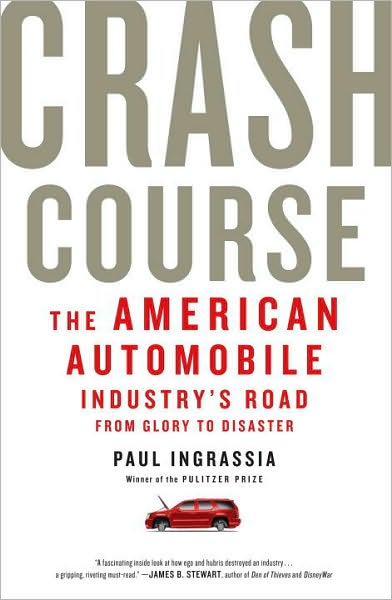 Hubris. Paul Ingrassia uses that word several times in his meticulous historical analysis of “what went wrong” with the U. S. automotive industry. But, Ingrassia doesn’t stop there. He includes all the mistakes the Japanese made in the American auto market, too. There’s plenty of blame to spread around from General Motors betting the price of gas would stay at $1.00 a gallon so SUVs would stay a viable (and profitable) product line–they lost that bet Big Time–to the United Auto Workers negotiating the infamous Job Bank that paid laid-off workers almost all of their salary to do Nothing (at a cost of $400 million). Colossal blunders, greed, excess, abuse of power, and denial of Reality round out Ingrassia’s fascinating story. I highly recommend Crash Course. GRADE: A
Hubris. Paul Ingrassia uses that word several times in his meticulous historical analysis of “what went wrong” with the U. S. automotive industry. But, Ingrassia doesn’t stop there. He includes all the mistakes the Japanese made in the American auto market, too. There’s plenty of blame to spread around from General Motors betting the price of gas would stay at $1.00 a gallon so SUVs would stay a viable (and profitable) product line–they lost that bet Big Time–to the United Auto Workers negotiating the infamous Job Bank that paid laid-off workers almost all of their salary to do Nothing (at a cost of $400 million). Colossal blunders, greed, excess, abuse of power, and denial of Reality round out Ingrassia’s fascinating story. I highly recommend Crash Course. GRADE: A


Like reading about the death of a family member. Every family I know has someone in this business. Just can’t read this one.
I know how you feel, Patti. There’s still two big GM plants in Western New York and a Ford plant. But they’re shadows of their former glory. I worked for General Motors during the summers in the 1990s as part of their Quality Educator program. Then, from 2001-2006, I was part of a PEL training program. My part was explaining the economic environment. The UAW and GM workers nicknamed me “Dr. Doom” but most of my forecasts, unfortunately, came true.
Looks pretty interesting, though I bet I’m familiar with just about everything he says, since I read quite a lot about the industry and have followed it for years.
I’m fairly knowledgeable about the auto industry, Rick, yet Ingrassia had a fact or two on every page that I didn’t know about. I didn’t know the Honda management in the U.S. were shaking down their dealers for “gifts” and money. And I didn’t know that Toyota thought the SUV would be a “fad” and was slow to introduce one of their own. This is the best auto industry book of the 21st Century so far.